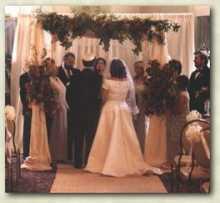The modern Jewish wedding is a combination of ancient traditions and culture-wide secular practices, a proper reflection of how Jews fit into modern society. Many elements of a Jewish wedding would be familiar to anyone who grew up in Western culture. Men wear tuxedos, the bride wears a white dress with a veil and train, the ceremony is most often followed by a formal reception. Little about the ceremony itself would seem esoteric to an outsider, though there are some symbols and rituals that are unique to the Jewish wedding that bear some explaining.
All Jewish wedding ceremonies are preceded by the signing of the ketubah. This is a marriage contract that dates back a little less than 2000 years ago at the beginning of the Rabbinic Age in Jewish practice. The signed ketubah is read aloud by the rabbi at the ceremony itself as proof of the agreement between the two parties being joined. For a more detailed explanation of the form and function of the ketubah, please see our previous article on the topic.
After the signing of the ketubah, the public ceremony begins. This is where the wedding has the most similarity to the traditional Western ceremony. The wedding party makes a formal procession at the scene of the ceremony, usually at the synagogue. The groom arrives just prior to the bride and the two are joined by their hand-selected matrons, maids and groomsmen. The wedding party does not line up by gender on either side of the betrothed, though. They are broken up into four groups, usually half representing the groom and half representing the bride. They stand at the four corners of the khuppah, the ceremonial canopy under which the bride, groom and rabbi stand.
The khuppah is usually a slightly ornate covering consisting of four thin posts and a cloth top. The canopy symbolizes the home the new couple are establishing with their marriage. The friends and family standing at the four corners represent the foundation of that home. This is a reminder that a Jewish home can only stay upright with the help of loved ones and community, especially the cooperation of the two families being joined by the wedding.
It is traditional to exchange rings, as per usual. It has been popular since the 20th century to recite the poetic phrase "ani l'dodi v'dodi li" from The Song of Songs, meaning "I am my beloved's and my beloved is mine" at this point in the ceremony.
One of the oldest elements of the Jewish wedding is the recitation of the Seven Blessings. This ritual has been a part of Jewish weddings since pre-Talmudic times, possibly even pre-Rabbinic. The Seven Blessings recount, literally or in metaphor, the gifts of prosperity, continued creation, humanity, holiness, Jewish culture, marriage and celebration. It is traditional for the bride and groom to drink from a glass of wine to toast the blessings as well.
The last Jewish wedding tradition is the breaking of a glass by the groom. A small glass is covered by a cloth and the groom steps on it at the pronouncement of the marriage. This symbolizes the potential trials the new couple will face in their life together. It depicts the destruction of something fragile that is nonetheless contained. The cloth can be seen as a miniature khuppah, showing the ability of a strong marriage to overcome strife.
These are the unique rituals of the Jewish wedding. They are powerful symbols of the life the new couple will lead together, a combination of law, family and joy.
